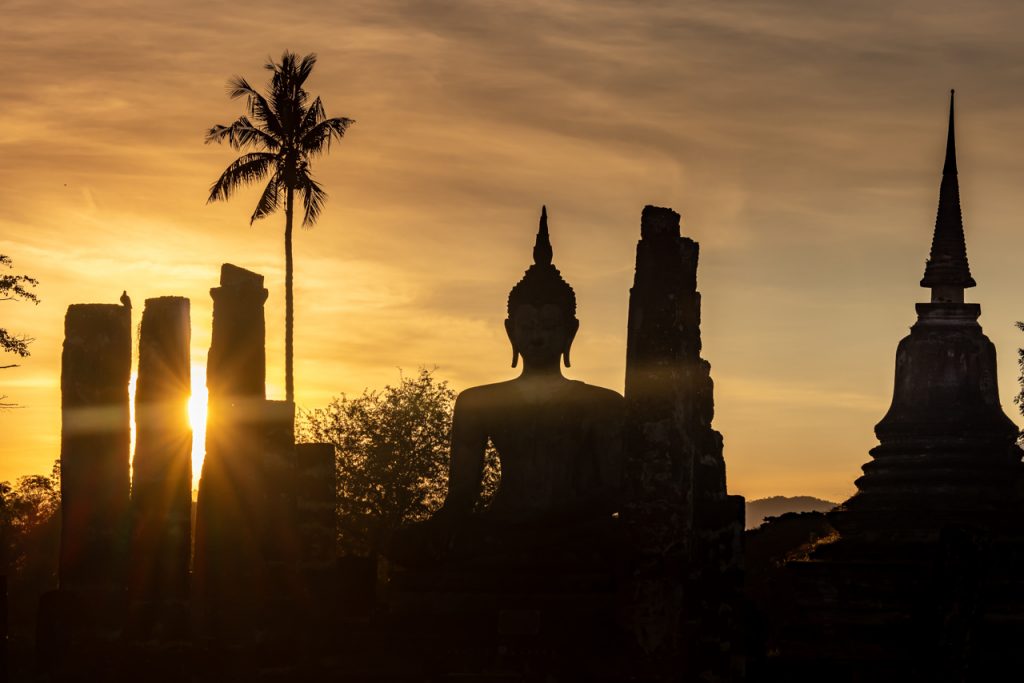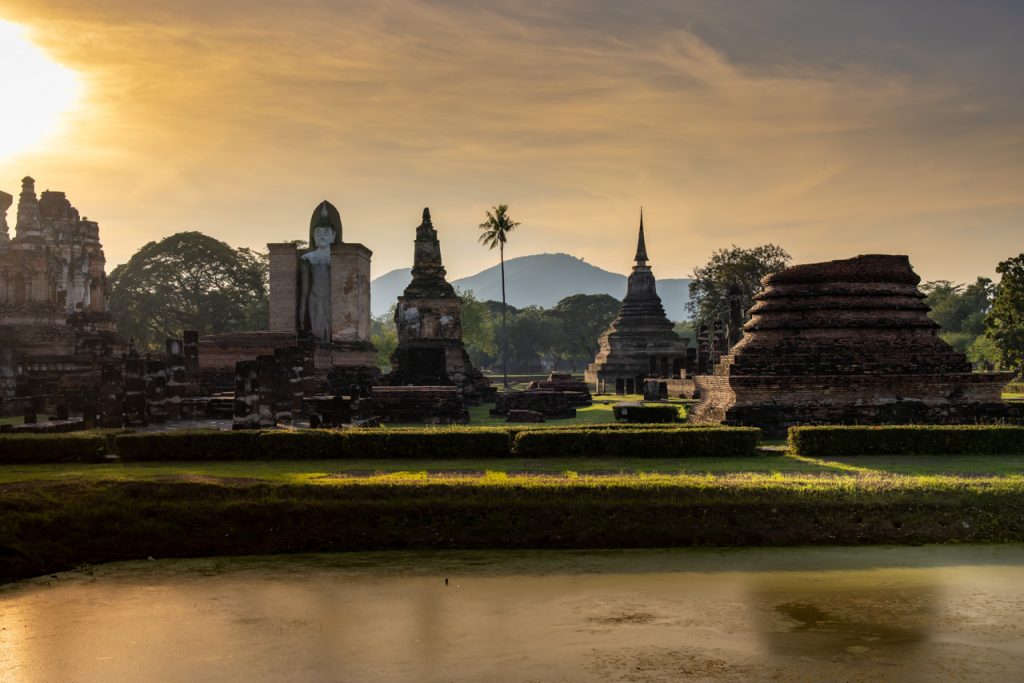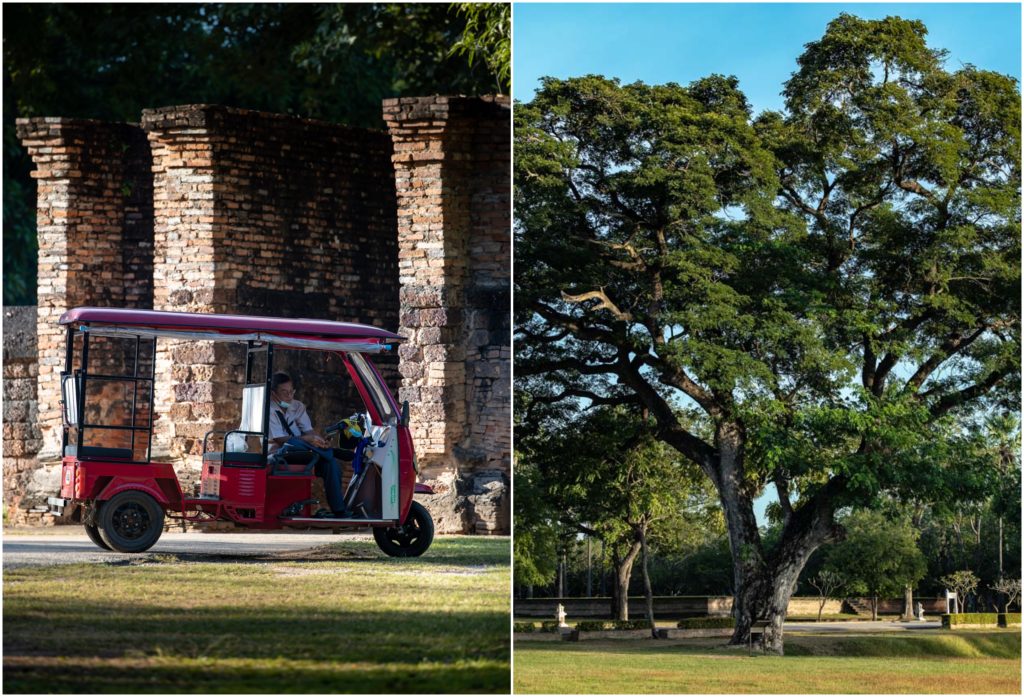In northwestern Thailand, the ruins of a historic royal city lie. We visited Sukhothai for two days and encountered more temples than tourists. But also, beautiful Buddhist traditions and authentic village idyll. Here is our guide on things good to know, where to stay, plus more.
Written by Mette / Photo by Martin
Translated from Danish
Sukhothai was the second stop on our tour of Northern Thailand. And how glad we are that we jumped off here – a little more than halfway on the route between Bangkok and Chiang Mai. Before arriving, we knew nothing about Sukhothai but had become curious to experience the temples after seeing a few pictures.
The old royal city looks like a movie set with its abandoned temples, sky-striking columns from royal palaces, and several meter-high Buddha statues, mirrored in the surrounding lakes.
A setting that certainly recalled memories from our trip to Angkor Wat. However, few temple complexes in Southeast Asia can match Cambodia’s temple city if you ask us. But Sukhothai has its own trump cards and a unique history, which is also the reason why the temples are among Thailand’s most important places.
The history of Sukhothai
In 1238, Sukhothai was part of the Khmer Empire when a local Thai leader led a rebellion against the rule and formed a new kingdom with the city as its capital. In Sanskrit, Sukhothai means ‘dawn of happiness’, and in a way, the name embraces the city’s cultural significance. Historians believe that it was here that Thailand’s Buddhist religion was introduced, and the alphabet of the country was created.
The Sukhothai kingdom had a total of nine kings on the throne before it was conquered and subjugated by AYUTTHAYA in the mid-14th century. The royal city was abandoned, but today the remains still stand and tell of a golden period in Thailand’s history. In the 1960s, the ruins were rediscovered, partially restored, and recognized as World Heritage by UNESCO in 1991.


Is Sukhothai worth a visit?
Having visited the two temple cities of AYUTTHAYA and Sukhothai back-to-back, it’s hard not to compare the two and pick a favourite. Ours is Sukhothai. The historical park probably includes both fewer and smaller temples, and there is a longer distance between them than in Ayutthaya. But that’s also why we favor Sukhothai.
Where Ayutthaya is located in the city, the temples of Sukhothai are surrounded by nature. And it tastes a bit like an Indiana Jones adventure when a stupa suddenly appears in a forest of old trees. Or when you have to crane your neck back to meet the eyes of a huge Buddha enthroned with the mountains as a backdrop.
Out here the only sounds are the birds and your camera. The distance to Bangkok means that there are fewer day-trippers, and motorized vehicles are prohibited in the park. Our only complaint is that the park is rather groomed, which takes away a bit of the authentic feel. Nevertheless, it is beautiful, and the peaceful country idyll makes the experience of the temples very special.
As a bonus, the small town of Old Sukhothai, located next to the entrance of temple park, is a charming acquaintance. It is a good base for a night or two and offers 11 wonderful things to do. But one, in particular, has made the list of our most memorable from the entire trip: At the city’s old temple, all visitors are invited to participate in giving alms to the monks.

13 THINGS GOOD TO KNOW
BEFORE VISITING SUKHOTHAI
#1 – Where is Sukhothai
Sukhothai Historical Park is located in northwestern Thailand – approx. 450 km north of Bangkok and 285 km south of Chiang Mai. The main attraction is the historical temple park located at the small town of Old Sukhothai. Read our guide on 11 things to do in Sukhothai.
#2 – The temple park
Sukhothai Historical Park spreads out over 70 km2 and is divided into five separate zones with 200 historical sites. The areas are named after their geographical location around the city of Old Sukhothai. Central, Northern, and Western are the most popular. All five zones are within cycling distance of the old city, and the largest temples in each zone can be experienced in one day with a little determination and big passion of temples.
#3 – Experience the temples by bike
Experiencing the temples by bicycle is the obvious choice. It is easy both to cycle around the park, but also on the lightly trafficked country roads between the areas. You can rent bicycles at the small shops located at the entrance to Central, along the main street of Old Sukhothai. We paid 30 baht per bike for a day.

#4 – Entrance ticket
You have to pay 100 baht at the entrance for entry to three of the zones: Central, Northern, and Western. If you bring a bicycle, it costs 10 baht extra. The tickets are valid for one day and are valid regardless of how many times you drive in and out. You are free to explore the other areas and monuments scattered around Old Sukhothai.
#5 – Opening hours
The three zones that require an entrance ticket – Central, Northern, and Western – are open between 6.30 am and 7.30 pm. You can visit the other areas around the clock.
#6 – Dress code
Although the temples are no longer active, they are still religious monuments. Therefore, you must dress appropriately. If you plan to visit the temples in the middle of the day, when the sun is strong, it is good to remember sunscreen, sunglasses, and a hat.
#7 – The 5 most famous temples
We only had one day in the temple park and prioritized the most famous temples and buddha statues:
Wat Mahathat (Central)
Wat Si Sawai (Central)
Wat Sa Si (Central)
Wat Phra Phai Luang (Northern)
Wat Si Chum (Northern)
On the cycle trip between Central and Northern, we also cycled past Wat Sorasak, which is worth a stop to see the beautiful elephant figures. In addition, several people recommended passing by Wat Saphan Hin in the Western park. Unfortunately, we didn’t make it, but the temple is a bit up the mountain and should have a beautiful view. The tip is hereby passed on.

#8 – Best time to experience the temples
Apart from the fact that the sun can baking hot in the middle of the day, there are several advantages to splitting the day’s temple hunt into two. There is something magical about experiencing the park early in the morning when there are almost no other tourists, and at the end of the day, when the light is golden and the temples are reflected in the lakes.
The entrance tickets are valid all day, so you can drive in and out as many times as you want. We cycled around ourselves and saw a selection of temples in the morning; drove back to town for lunch; and came back in the afternoon to watch the sunset.
#9 – Where to watch the sunset
Watching the sunset in Sukhothai is one of our favorite experiences in the temple city. We were recommended two places in Central: the Buddha statue at Wat Mahathat (see photo) and the view of Wat Sa Si from the lake shore (see photo). The two are close to each other, so if you only have one day, you can manage to experience a bit of the magic of both places.

#10 – Find the temples without wifi
It is relatively easy to find your way when you drive around the park and on the country roads between the areas. With that said, we only saw a few signs. Download, for example, Google Maps or the Maps.me app on your phone, so that you have an offline map at hand. We had previously put pins in the map at the temples we wanted to see, which also provided a route to follow.
#11 – Map of the temple park
On the Canadian travel blog ‘BBQ Boy & Spanky’ you can see a useful map of the temples and their location in the five different areas. Under the map they share more pictures and useful information about the three largest temples.

#12 – Best time to visit Sukhothai
In terms of weather, the best months are from November to Febraury. Like everywhere else, the high season is around December and January, when there are the most tourists.
#13 –The festival of lights
In addition, it is popular to visit Sukhothai during the Loy Krathong light festival, which takes place every year in November. Here, the temple lakes are transformed into a sea of light with hundreds of floating candles, which the locals launch in small boats folded from leaves.

BEST PLACE TO STAY
IN SUKHOTHAI
Two different towns
We found it a little confusing ourselves, so let’s clarify right away: Sukhothai includes two independent towns – the new, larger trading city of New Sukhothai and the small town of Old Sukhothai. It’s about 12 km between the two cities.
Best place to stay
The entrance to the central part of the temple park is at the end of the main street in Old Sukhothai. We, therefore, preferred to stay in Old Sukhothai, as we could easily walk and cycle into the park in a few minutes. If you stay in New Sukhothai, you must e.g. take a tuk-tuk or bus to Old Sukhothai to get to the temple park. The drive is only 12 km, so it is manageable.
Hotels in Old Sukhothai
In the center of Old Sukhothai, the range of accommodation options is limited. Here you will find a handful of small guesthouses and hostels. If you drive a little off the main road towards New Sukhothai, you will find a few smaller hotels that also have a pool. You will find the largest selection of hotels in all price ranges in New Sukhothai.
Where we stayed
We stayed at Oldtown Boutique House Sukhothai, which is a small, family-run guesthouse. There are 4 budget rooms with a private bathroom and a common lounge with coffee, tea and snacks. The rooms are quite simple, but it’s nice and clean, the hospitality is great and the location is perfect. The house is located just behind the city’s temple and museum. From here you only have a few minutes’ walk to the main street, as well as to the entrance to the temple park and the bus stop in the city.
What to do in Old Sukhothai
Most people spend their time in the historical park – and with good reason. But we found out that Old Sukhothai hides a handful of wonderful experiences that make the small villa worth spending a night. Read more in our guide on 11 things to do in Old Sukhothai.

TRANSPORT TO SUKHOTHAI
There are several ways to get to Sukhothai, located almost halfway between Bangkok and Chiang Mai in Northern Thailand.
Bus
The most popular way to get to Sukhothai is by bus. You can find more info on rome2rio, which is the booking portal we use to plan transport and book tickets in advance.
If you have time in your itinerary, you can save some money if you buy tickets directly at the bus station. Often it is not necessary to buy a ticket in advance. But check just in case if you know you need to get from A to B at a specific time. Especially in the high season, when the buses fill up faster.
Train
There are no direct trains to Sukhothai. The nearest train station is Phitsanulok, which is approx. 60 km from New Sukhothai and approx. 72 km from Old Sukhothai. If you come by train from Bangkok or Chiang Mai, you must therefore get off in Phitsanulok and, for example, take the bus to New Sukhothai or Old Sukhothai.
The train between Bangkok and Chiang Mai runs through Phitsanulok several times a day. You can see the train schedule here. Trains in Thailand are notoriously late, so please allow a little extra travel time.

By bus from Phitsanulok train station
In Phitsanulok, the train station and the bus station are not in the same place. We therefore took a tuk-tuk from the train to the bus station (10 minutes drive, 60 baht per person), where we bought a bus ticket to Old Sukhothai at the counter.
The bus runs through New Sukhothai, which is a major trading town, and on to Old Sukhothai. The journey takes 1 hour, and the bus departs several times a day between 6 a.m. to 4:30 p.m. If you want to go faster, we met other travelers who had taken a tuk-tuk all the way from Phitsanulok to Sukhothai.
The bus station in Old Sukhothai
If you choose to live in Old Sukhothai, you will find the city’s local bus station at the end of the main street – at the opposite end of the temple park. To call it a bus station, however, is an exaggeration. There are a few plastic chairs in front of a shop where an elderly man sits, selling bus tickets. You can find the exact location on Google Map by searching for Wintour Bus Station.
Airplane
There are daily flights between New Sukhothai and Bangkok.



Reading “And it tastes a bit like an Indiana Jones adventure….” after playing Indiana Jones and The Great Circle which has a Sukhothai-based map put a smile on my face.